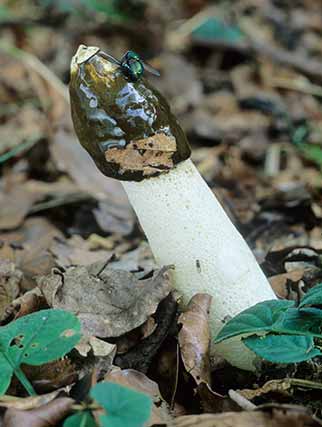Stinkhorn (Phallus impudicus)

just a single fly to feast
The Stinkhorn when mature is absolutely distinctive and readily recognisable. The fruiting body is a hollow, cylindrical stalk, exceptionally growing to a height of 20 centimetres, at the tip of which is a conical cap initially covered in dark, olive-green, spore-filled mucus so foul smelling, so offensive that it has been likened to the smell of rotting flesh.
In nature, though, everything has its purpose, and so it is with the Stinkhorn, for that awful aroma attracts flies from far and wide to feast on the mucus and, in so doing, distribute the spores from within bits that inevitably become attached to their legs. Remarkably rapidly, all is removed leaving behind a naked, elongated conically shaped cap covered by a network of raised ribs.
Stinkhorns grow in humus-rich ground amongst leaf litter - it is sometimes said to be associated with rotting wood buried in the soil - under oak, beech and some conifers and is relatively common and widespread in the New Forest. Attention to it is usually first attracted by the disgusting odour that is noticeable, even to insensitive human nostrils, from some considerable distance.
The stalk, though, emerges from an egg-shaped, underground globular structure considered in days gone by to be a spirit egg useful for making love potions and cures for gout, rheumatism and epilepsy. (Its aphrodisiac qualities were presumably imagined from the phallic shape). The egg when young and fresh is edible, but is not generally recommended.
Although most typically associated with autumn, Stinkhorns do appear in small numbers from late May, although many of these early examples are concealed by spring and summer grasses.
Warning: refer to a good, comprehensive fungus field guide to confirm identification, and only eat those species known without any doubt whatsoever to be edible - people have died after eating certain poisonous specimens.
References:
Mushrooms and other Fungi of Great Britain and Europe - Roger Phillips
The Mushrooms and Toadstools of Britain and North-western Europe - Marcel Bon
Fungi of Britain and Europe - Stefan Buczacki and John Wilkinson
The MacDonald Encyclopedia of Mushrooms and Toadstools - Giovanni Pacioni
Fungi of the New Forest: A Mycota - Edited by Gordon Dickson and Ann Leonard
A Passion for Mushrooms - Antonio Carluccio
More links
Other related links
Search this site

Sadly, 58 animals were killed - 35 ponies, 13 cows, 8 donkeys and 2 sheep, whilst a further 32 were injured - 3 pigs, 9 donkeys, 11 cows and 9 ponies.
(Forty-three accidents occurred in daylight, 15 at twilight and 101 in the dark. Twenty-seven accidents were not reported by the driver involved).
Here's just one horrific example - Three donkeys killed in collision with van at notorious New Forest blackspot (Advertiser and Times)

